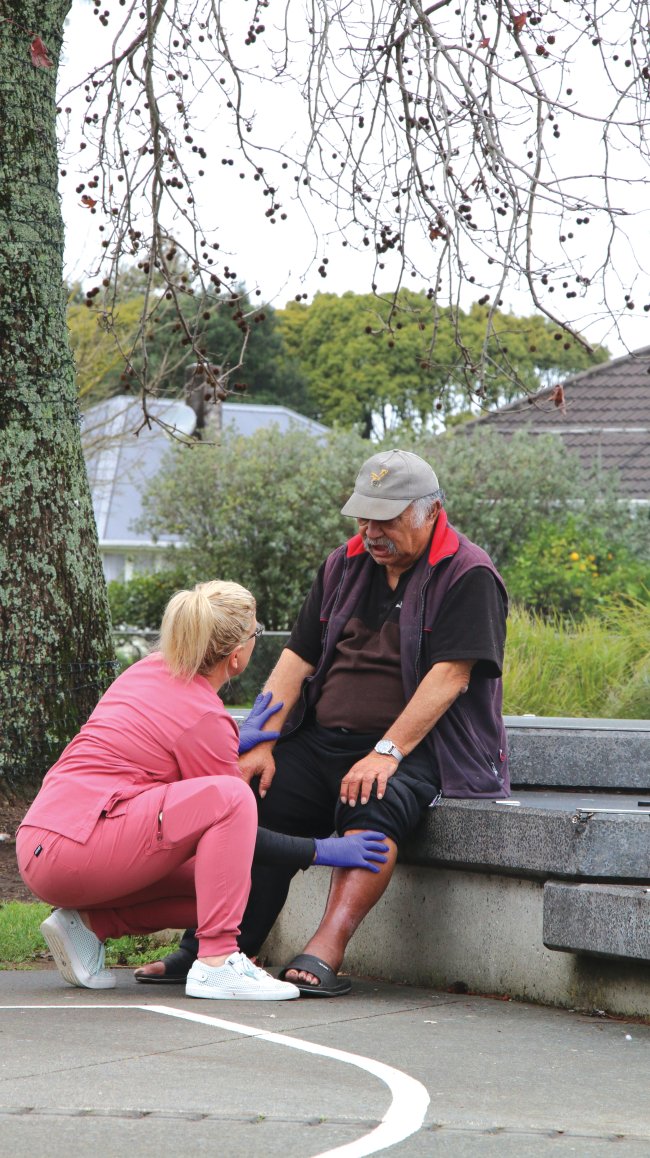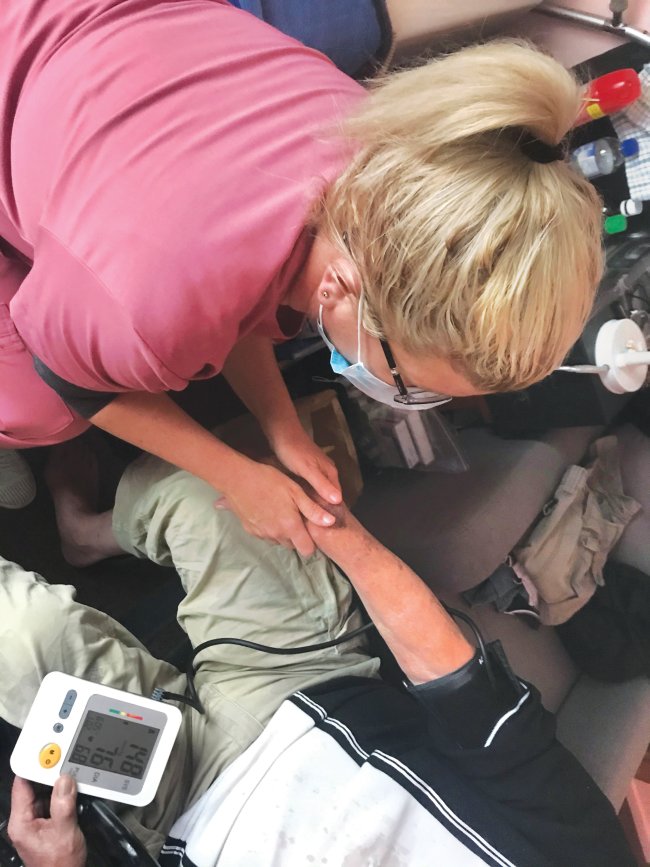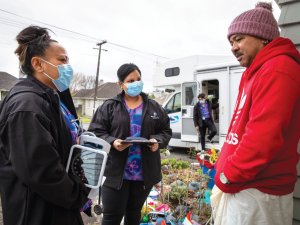Respiratory physician Lutz Beckert considers chronic obstructive pulmonary disease management, including the prevention of COPD, the importance of smoking cessation and pulmonary rehabilitation, and the lifesaving potential of addressing treatable traits. He also discusses the logic of inhaler therapy, moving from single therapy to dual and triple therapy when indicated, as well as other aspects of management
HEALS ON WHEELS
HEALS ON WHEELS

Here at New Zealand Doctor Rata Aotearoa we are on our summer break! While we're gone, check out Summer Hiatus: Stories we think deserve to be read again! This article was first published on 20 July 2022.
Chosen by Alan Perrott: Mobile primary care is highlighting just how much community need remains hidden behind closed doors. Those doing the door knocking say the work is as rewarding as it is potentially harrowing, and they are still only dipping their toes in it. Why aren't they better supported?
We’d just literally pulled out of the driveway when the police raided the house
It’s a bitterly cold Wednesday morning outside the Ōtāra Kai Village food bank and Thomas Swinburn is slowly working his way through the patient crowd.
“We’re offering free medical care this morning, is there anything we can help you with?” Mr Swinburn asks.
Several people have already taken up the offer when the medical student reaches a Cook Island Māori man who has just been handed his supplies.
Yes, he would like to see a doctor, but first he needs to bus home and deliver the food to his family. After some coaxing, he climbs into Te Iti Pounamu Hauora’s “medical bus” and explains to GP Juliet Tay how the chest pain he has been enduring for several weeks has reached his neck and he feels dizzy whenever he moves.
After an examination, Dr Tay asks nurse practitioner Rebecca “Beccy” Fenn to call an ambulance.
Amazingly, there’s one waiting at the lights outside the Ōtāra shopping centre, so Ms Fenn runs out to flag it down – sometimes scrubs are a useful identifier. Even then, it takes a solemn promise from the team’s healthcare assistant, Lonah Fiaui, that she will deliver the food herself, for the patient to budge. She will also collect some clothes and deliver them to him in hospital.
Last heard, an urgent ECG and blood tests had ruled out cardiac problems, but he has bronchiectasis, and his pain is likely due to an infection. But he’s doing well.
And that was just one of the morning’s highlights. From arriving to find two rough sleepers who rejected any help, the team treated nine people in almost two hours.
There was Kapii, a 68-year-old Cook Island Māori, who has diabetes but can’t afford to see her GP as she has had three deaths in her family and is supporting her relatives as best she can.
Then there was 76-year-old Tom, who is also focused on his family and has been ignoring a leg infection for several weeks. He is seen outside the bus as Dr Tay is busy inside with a patient in mental distress who takes half an hour before she will speak.
And then there was Wayne, a solo father and sickness beneficiary, whose wife is in care, and he hasn’t seen a GP in four years. Dr Tay diagnoses new hypertension, likely fatty liver and high cholesterol, and gets his contact details to follow up.
He’s there with a friend, also a sickness beneficiary, who is only taking half of his daily seizure medication dosage because of a $5 increase in the prescription charge. Like the others, he says he can’t afford primary care and only seeks help when things feel life-threatening.
They’ve all been long, complex consultations and the crew is satisfied with their work: “It’s been a bit of a rush,” says Ms Fenn, “but it’s good. That’s what we want.”
But you never know what’s going to happen when you’re out in the community. Just as the team is preparing to leave, a young, intoxicated man tosses two planks with protruding nails under the bus and then leans against a fence to apply some eye drops and watch what happens.
As threats to service’s viability go, it’s probably the easiest one they have to deal with right now.
Te Iti Pounamu Hauora escalated from a dinner conversation between Dr Tay and Ms Fenn to a six-month pilot in February after Alliance Health Plus PHO stumped up $210,000 in funding.
The money runs out next month and they are struggling to find more.
The pilot is currently subcontracted to Manurewa practice Greenstone Family Clinic with Dr Tay normally taking the bus – they call it a bus, but it’s a campervan – out in the morning and returning to the practice around noon so Ms Fenn can take over.
Healthcare assistant Ms Fiaui arrived from Totara Hospice to complete the trio. She handles logistics and recordkeeping, while also helping as an intermediary with Pacific patients.
For the past few weeks, they have been joined by Mr Swinburn, a 24-year-old fifth-year medical student at the University of Auckland. Next month, he heads to Brussels to present his award-winning essay on a patient encounter to the International Balint Congress.
The team accept referrals from a range of NGOs and healthcare providers, but their preference is to ask community groups to show them where the need is, then park up and approach people directly. As the man with the planks shows, the responses are highly variable, but Dr Tay is hopeful repeated visits will build trust.
For now, they are at the Ōtāra shopping centre on Monday afternoons, to catch teenagers heading home from school, and Wednesday mornings when the food bank is operating.
On Thursday mornings they park up behind the Māngere Town Centre where, with help from community group I AM Māngere, they are slowly connecting with the homeless community.
It can be confronting work. A few weeks ago, a nine-year-old boy walked in, alone and drenched from the rain, asking for help with a sore throat. Home is difficult, he said, so he often sleeps rough. Dr Tay is worried; they haven’t seen him since.
After two stops to check in on patients, we head back to Greenstone. Dr Tay likes to drive so she can wind down.
“I have to say, it’s a career highlight. As an experience it has been amazing, and the impacts of even the little interventions have, for me, been significant. So, I would love to promote this model of care as an option for other GPs to try, it is just incredibly rewarding and the difference we are making in the lives of people, tangibly, is not something we always get to see.
“I’m not saying we don’t miss normal consults. I do miss the long-term relationships we build, and these encounters can be very fleeting but, as a model of care, it works.
“With some patients, we have been able to see them a few times and it takes time, but you can turn small, acute interventions into long-term care.”
She is also excited about the possibility of getting access to Middlemore Hospital’s discharge summaries of patients who are not enrolled with a GP: “That will be huge.”
As for Mr Swinburn, the last month has been mind-expanding. At our last stop he performed a supervised shoulder exam and consultation on an unenrolled man who had fallen and damaged himself during a seizure.
“This is an incredibly rare opportunity for a student,” he says, “the traditional setting is sitting in a room with a GP. You’re getting the skills, but this is so much more, things you can’t teach. You’re learning from observation and connecting with people where they live.
“Comparing hospital work to home visits – you read about things like overcrowding, poverty and all those sorts of things and you say ‘oh yes, that’s terrible’, but you really have no idea what that looks like. To actually see it, in person, that really just underscores to me the importance of a strong public health system and working closely with primary care.”
The memory of one of his first home visits lingers: “It wasn’t a big home, but it was crowded, with probably nine people, and it was dark and musty. The only food they had was a bottle of Coke, a bag of Doritos, and a tray of eggs. You don’t see that kind of context in hospital, and it has stuck with me.”
Back at base in Manurewa, Dr Tay departs for an afternoon of normal duties as Ms Fenn and Ms Fiaui prepare for an afternoon of home visits. At least they would, if the phone would stop ringing.
The ball seems to be rolling with three calls from groups hoping to arrange regular visits from the medical bus. Every third Thursday of the month – funding permitting – looks to have been claimed by Grandparents Raising Grandchildren, a trust supporting more than 5700 carers around the country.
Someone from I AM Māngere then calls to set up an appointment and offer “Aunty J” and “Aunty B” as many letters of support for funding as the team needs: “We just want to say thank you for all the work you do.”
The phone then chimes one last time, but the details of the conversation are drowned out as both women start screaming with joy. Last weekend, Ms Fenn emailed Te Aka Whai Ora – Māori Health Authority chief executive Riana Manuel “nurse to nurse” asking for help.
Dr Tay has just seen her reply offering a meeting the following week. It may come to nothing, but it’s hope. “Oh, my gosh, how exciting,” splutters Ms Fenn as she puts the bus into gear and claps Ms Fiaui on the back one more time.
We’re soon bouncing through deepest suburban Manurewa and Ms Fiaui points at a house: “That was the first house we visited. We were helping their kids and, I don’t know, I had a strange feeling, and I said: ‘We had better go now’. We’d just literally pulled out of the driveway when the police raided the house.”
The first of our three stops isn’t half as exciting. A chap who has been awaiting a knee replacement since January. He just needs three normal blood pressure results first.
Ms Fenn is also keeping an eye on how his mother is doing – she hasn’t seen a GP in who knows how long, and has suspected dementia.
We head to Pride Project, another community group. It’s supposed to be a quick in and out, but the inevitable question pops up: “While you are here, can you see…?”
We end up staying long enough for neighbours to walk to the end of their driveways for a look before their new patient leaves, but not before taking a quick selfie. He walks off, talking loudly to his phone. Presumably, it’s now a social media post, and there’s only one thing worse than being talked about...
Our final job for the day takes us down a narrow alley that cuts through the middle of a 1980s-style housing development. The houses are cheek by jowl, people are out mixing in their front yards, and all are being entertained by a particularly loud stereo playing a Marvin Gaye remix. The alley isn’t campervan friendly, and we manage to block several cars trying to enter and exit.
But then the 15-year-old we are here to see strolls up with her even younger stepsister. She’s staying with grandparents after moving up country to escape the constant gang presence at her parents’ home.
In cheerful tones, she holds out her hands to show the badly infected cuts on her fingers before shifting the conversation to contraception. She doesn’t want to get pregnant, but she also doesn’t want any kind of invasive procedure, so condoms will do fine, thanks. She then wants a lift to her home which is, at most, 20m away. Teenagers. Don’t forget the antibiotics. “She’s a bright one, that one,” says Ms Fenn as she waves her off.
Asked how she deals with such deeply personal encounters every day, she says: “Well, when we started, it was a massive leap of faith, we just decided to see what happens.
“Some days you go home, and we see people, you know, in some pretty extreme conditions, and it’s heavy, and I guess people feel ‘heavy’ differently, but I do think about burnout.
“I was [telling] a girlfriend, ‘I’m not sure what half-life this will have.’ I think maybe two or three years, but if we can establish this service, how amazing would that be.
“It’s far and away the coolest job I’ve ever done.”
Almost a third of the patients seen by mobile service Te Iti Pounamu Hauora have been re-engaged with their GP, says a report from Alliance Health Plus PHO.
The report was released by the PHO’s practice network manager Vanita Hira last month and covers the service’s efforts for its first two months, 21 February to 27 March 2022.
It says 260 referrals were received during that period, with 158 people having their acute need resolved, 72 people being offered help to re-engage with their GP, and 41 being referred to secondary care.
Fifty-three of those seen were unenrolled.
The total does not include those seen opportunistically during site visits.
The referrals were mostly Māori and Pacific peoples (119 and 109 respectively) and were almost evenly divided between females and males. Most had long-term conditions such as mental health issues, diabetes and cardiovascular disease.
Concerns prompting the referrals predominantly involved screening, mental health, skin conditions, and a mix of other issues such as wounds and help with prescription medicines.
Six of those seen had visited an emergency department five times in the previous 12 months.
The report says the services engagement numbers are increasing as its community network expands and trust builds.
The network is growing by developing connections with organisations such as emergency housing providers Penina Trust and Square Peg Housing, and NGOs such as Pride Project, Grandparents Raising Grandchildren and I AM Māngere.
Alliance Health Plus estimates the running costs at $450,000 a year, but says the economic case has identified downstream healthcare savings of $600,000 a year.
Te Iti Pounamu Hauora is funded by the PHO, but this support ends next month.
Says the report: “Without it, people will continue to use secondary care services for primary care health needs, and in some cases, people will die earlier than necessary due to lack of access to care and/or delayed diagnosis and intervention.”
The report urges greater use of mobile health services to improve access to care for marginalised communities.








![Barbara Fountain, editor of New Zealand Doctor Rata Aotearoa, and Paul Hutchison, GP and senior medical clinician at Tāmaki Health [Image: Simon Maude]](/sites/default/files/styles/thumbnail_cropped_100/public/2025-03/Barbara%20Fountain%2C%20editor%20of%20New%20Zealand%20Doctor%20Rata%20Aotearoa%2C%20and%20Paul%20Hutchison%2C%20GP%20and%20senior%20medical%20clinician%20at%20T%C4%81maki%20Health%20CR%20Simon%20Maude.jpg?itok=-HbQ1EYA)
![Lori Peters, NP and advanced health improvement practitioner at Mahitahi Hauora, and Jasper Nacilla, NP at The Terrace Medical Centre in Wellington [Image: Simon Maude]](/sites/default/files/styles/thumbnail_cropped_100/public/2025-03/2.%20Lori%20Peters%2C%20NP%20and%20advanced%20HIP%20at%20Mahitahi%20Hauora%2C%20and%20Jasper%20Nacilla%2C%20NP%20at%20The%20Terrace%20Medical%20Centre%20in%20Wellington%20CR%20Simon%20Maude.jpg?itok=sUfbsSF1)
![Ministry of Social Development health and disability coordinator Liz Williams, regional health advisors Mary Mojel and Larah Takarangi, and health and disability coordinators Rebecca Staunton and Myint Than Htut [Image: Simon Maude]](/sites/default/files/styles/thumbnail_cropped_100/public/2025-03/3.%20Ministry%20of%20Social%20Development%27s%20Liz%20Williams%2C%20Mary%20Mojel%2C%20Larah%20Takarangi%2C%20Rebecca%20Staunton%20and%20Myint%20Than%20Htut%20CR%20Simon%20Maude.jpg?itok=9ceOujzC)
![Locum GP Helen Fisher, with Te Kuiti Medical Centre NP Bridget Woodney [Image: Simon Maude]](/sites/default/files/styles/thumbnail_cropped_100/public/2025-03/4.%20Locum%20GP%20Helen%20Fisher%2C%20with%20Te%20Kuiti%20Medical%20Centre%20NP%20Bridget%20Woodney%20CR%20Simon%20Maude.jpg?itok=TJeODetm)
![Ruby Faulkner, GPEP2, with David Small, GPEP3 from The Doctors Greenmeadows in Napier [Image: Simon Maude]](/sites/default/files/styles/thumbnail_cropped_100/public/2025-03/5.%20Ruby%20Faulkner%2C%20GPEP2%2C%20with%20David%20Small%2C%20GPEP3%20from%20The%20Doctors%20Greenmeadows%20in%20Napier%20CR%20Simon%20Maude.jpg?itok=B0u4wsIs)
![Rochelle Langton and Libby Thomas, marketing advisors at the Medical Protection Society [Image: Simon Maude]](/sites/default/files/styles/thumbnail_cropped_100/public/2025-03/6.%20Rochelle%20Langton%20and%20Libby%20Thomas%2C%20marketing%20advisors%20at%20the%20Medical%20Protection%20Society%20CR%20Simon%20Maude.jpg?itok=r52_Cf74)
![Specialist GP Lucy Gibberd, medical advisor at MPS, and Zara Bolam, urgent-care specialist at The Nest Health Centre in Inglewood [Image: Simon Maude]](/sites/default/files/styles/thumbnail_cropped_100/public/2025-03/7.%20Specialist%20GP%20Lucy%20Gibberd%2C%20medical%20advisor%20at%20MPS%2C%20and%20Zara%20Bolam%2C%20urgent-care%20specialist%20at%20The%20Nest%20Health%20Centre%20in%20Inglewood%20CR%20Simon%20Maude.jpg?itok=z8eVoBU3)
![Olivia Blackmore and Trudee Sharp, NPs at Gore Health Centre, and Gaylene Hastie, NP at Queenstown Medical Centre [Image: Simon Maude]](/sites/default/files/styles/thumbnail_cropped_100/public/2025-03/8.%20Olivia%20Blackmore%20and%20Trudee%20Sharp%2C%20NPs%20at%20Gore%20Health%20Centre%2C%20and%20Gaylene%20Hastie%2C%20NP%20at%20Queenstown%20Medical%20Centre%20CR%20Simon%20Maude.jpg?itok=Z6u9d0XH)
![Mary Toloa, specialist GP at Porirua and Union Community Health Service in Wellington, Mara Coler, clinical pharmacist at Tū Ora Compass Health, and Bhavna Mistry, specialist GP at Porirua and Union Community Health Service [Image: Simon Maude]](/sites/default/files/styles/thumbnail_cropped_100/public/2025-03/9.%20Mary%20Toloa%2C%20Porirua%20and%20Union%20Community%20Health%20Service%20in%20Wellington%2C%20Mara%20Coler%2C%20T%C5%AB%20Ora%20Compass%20Health%2C%20and%20Bhavna%20Mistry%2C%20PUCHS%20CR%20Simon%20Maude.jpg?itok=kpChr0cc)